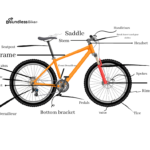Are you tired of a rattling chain that disrupts your smooth ride? Or perhaps it’s time for a new bike chain, but you’re hesitant to spend money on something that might not need replacing. Well, fear not! In this post, we’ll teach you the basics of chain maintenance and show you how to remove links from your bike chain like a pro. Say goodbye to frustrating rides and hello to smooth cycling with these easy steps!
How to Remove Links from A Bike Chain
To remove links from a bike chain, you’ll first need to determine how many links you need to remove. You can do this by wrapping the chain around the chainring and the cog, and then pulling the chain tight. Once you have determined the correct length, mark the link that you want to remove with a pen or marker.
Next, you’ll need to use a chain tool to push the pin out of the link you want to remove. Place the chain in the tool so that the pin lines up with the tool’s pin, then turn the handle to push the pin out. Be sure to only push the pin out far enough to separate the chain, and not so far that it falls out completely.
Once the chain is separated, you can remove the desired link and rejoin the chain. To do this, place the chain ends back together and insert a replacement pin into the holes, making sure it is going through the outer plates of the chain. Use the chain tool to push the pin in until it is flush with the outer plates.
Finally, it’s important to check the chain length once again to ensure that you have removed the correct number of links. If everything looks good, be sure to lubricate the chain before riding to keep it in good condition.
What You Need for Removing Links
If you’re like most cyclists, you probably don’t give your bike chain much thought—that is, until it starts making strange noises or skipping gears. At that point, it’s time to give your chain some TLC with a thorough cleaning and inspection. Part of this process may involve removing links from your bike chain in order to shorten it or replace a damaged link.
Here’s what you’ll need to remove links from your bike chain like a pro:
- Chain breaker tool
This specialized tool is designed for removing and installing bicycle chains. It usually has two pins that fit into the side plates of the chain and push out the rivet connecting the links.
- Pair of pliers
You may be able to get away with using a regular pair of household pliers, but investing in a good quality pair of bicycle-specific pliers will make the job easier and help prevent damage to your chain.
- Rag or towel
This will come in handy for wiping away excess lubricant after you’ve shortened or repaired your chain.
- Replacement link
Step by Step Guide to Removing Links

- Step 1: Determine how many links need to be removed Before you begin removing links from your bike chain, you need to determine how many links need to be removed. If you’re replacing a damaged link, you only need to remove one link. If you’re adjusting the length of your chain, you will need to remove two or more links, depending on how much you need to shorten the chain.
- Step 2: Locate the link to be removed Once you’ve determined how many links need to be removed, you need to locate the link that you want to remove. The easiest way to do this is to count the links from the back of the chain until you reach the one that you want to remove. Alternatively, you can use a marker or a piece of tape to mark the link that you want to remove.
- Step 3: Position the chain breaker tool on the link Now that you’ve located the link that you want to remove, you need to position the chain breaker tool on the link. The chain breaker tool has a small pin that you need to line up with the pin on the link. Make sure that the pin on the chain breaker tool is positioned on the side of the chain that you want to remove.
- Step 4: Turn the handle of the chain breaker tool until the pin is pushed out of the link Once the chain breaker tool is positioned on the link, you need to turn the handle of the tool until the pin is pushed out of the link. This will separate the link from the rest of the chain.
Final Steps
- Step 5: Use pliers to remove the pin completely from the link Now that the pin is partially pushed out of the link, you need to use pliers to remove the pin completely from the link. Hold onto the pin with the pliers and pull it out of the link. Be careful not to lose the pin, as you will need it later to reattach the chain.
- Step 6: Separate the chain at the broken link Now that the pin has been removed from the link, you can separate the chain at the broken link. Simply pull the two ends of the chain apart to remove the broken link.
- Step 7: Connect the chain again using a replacement link To connect the chain again, you need to use a replacement link. The replacement link should be the same type of link as the rest of the chain. Simply insert the pin into one end of the replacement link and then insert the pin into the other end of the link. Use pliers to push the pin in until it is flush with the link.
Different Ways to Seat A link
There are a few different ways to seat a link:
- You can use a quick-link pliers or similar tool designed specifically for this purpose
- You can use a pair of needle-nose pliers
- You can use your fingers (if they’re strong enough)
- Once all of your links are seated correctly, give your chain a quick wipe
Tips and Tricks for Easier Link Removal
- Use a chain tool: A chain tool is a specialized tool that makes removing and adding links to your bike chain quick and easy.
- Unhook the master link: The master link is the link that connects the two ends of the chain together. You can remove this link without the need for a chain tool.
- Push out a pin: Pushing out a pin is how you remove an individual link from the chain. You’ll need a chain tool to do this.
- Remove damaged links: If you have a damaged or bent link, it’s best to remove it from the chain entirely. Again, you’ll need a chain tool to do this.
- 5. Add new links: When you need to add new links to your bike chain, you can use either new pins or master links. both will require a chain tool for installation.
How to Tell if You’ve Removed Enough Links
It can be tricky to know when you’ve removed enough links from your bike chain. If you remove too many links, your chain will be too short and won’t be able to reach all the gears on your bike. If you don’t remove enough links, your chain will be too long and could fall off your bike while you’re riding.
Here are a few things to keep in mind when removing links from your bike chain:
- The number of links you need to remove will depend on the size of your bike frame and the length of your chain.
- If you’re unsure how many links to remove, it’s better to err on the side of caution and remove fewer links rather than too many.
- You can always remove more links later if needed, but it’s much more difficult to add links back into a chain once they’ve been removed.
Once you’ve removed the desired number of links from your bike chain, use a chain tool or a pair of pliers to close the end of the link so that it doesn’t come apart.
Common Mistakes to Avoid When Removing Links
- Removing too many links: One of the biggest mistakes people make is removing too many links from the chain. This can cause the chain to be too short, which can lead to problems with shifting and derailleur performance. Make sure to only remove the necessary amount of links and double-check your work before reassembling the chain.
- Forgetting to lubricate the chain: Before you reassemble the chain, it’s important to lubricate it with a good quality bike chain lubricant. This will help to reduce friction and prevent the chain from rusting or corroding over time. Skipping this step can result in poor performance and a shorter lifespan for your chain.
- Reusing a damaged pin: It’s important to never reuse a damaged or weakened pin when reassembling the chain. Always use a replacement pin to ensure the chain is secure and won’t fail when you’re riding.
- Forgetting to check the chain length: Once you’ve removed the desired links and reassembled the chain, it’s crucial to double-check the length of the chain. A chain that’s too short or too long can cause problems with shifting and performance, so take the time to check your work before riding.
- Over-tightening the chain: When you reassemble the chain, it’s important to make sure it’s not too tight or too loose. An overly tight chain can put unnecessary stress on your bike’s drivetrain, while a loose chain can cause poor shifting and even come off the bike. Be sure to adjust the chain tension as needed to ensure a smooth and safe ride.
FAQs
No, it is not recommended to reuse the pin that was removed from the chain. The pin may be damaged or weakened during the removal process, which could cause the chain to fail when you’re riding. It’s always best to use a replacement pin when reassembling the chain.
It depends on how many links you removed. If you removed more than a few links, it’s likely that your chain will be too short to use safely. In this case, you will need to replace the entire chain.
You should only remove links from your chain if it’s necessary, such as if you need to adjust the length of the chain or if you have a damaged link. Removing links too frequently can weaken the chain and cause it to fail.
Conclusion
With a few key tips and tricks, removing links from your bike chain doesn’t have to be difficult. Having the right tools on hand, along with patience and attention to detail can help you get the job done quickly and easily. And remember, if you’re ever in doubt or need extra support while working on your bike chain, it’s always best to consult a professional mechanic who will be able to provide expert advice and services.






